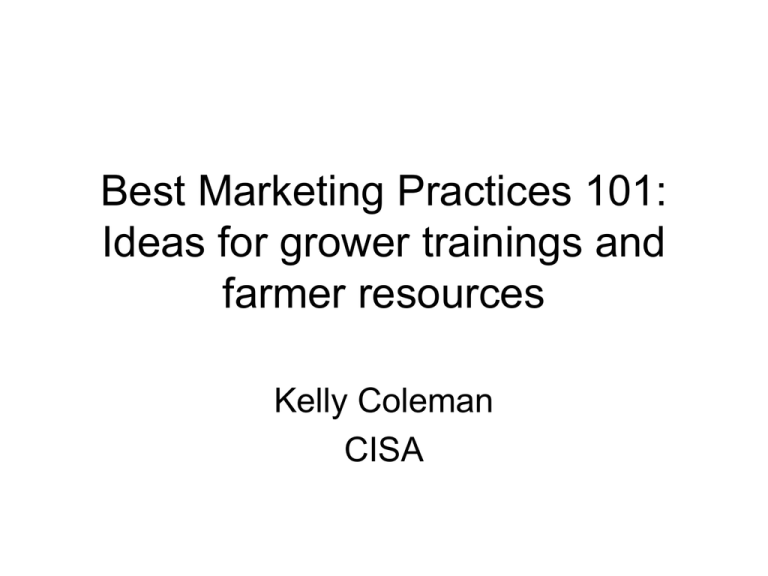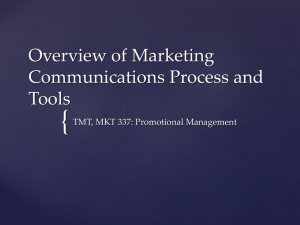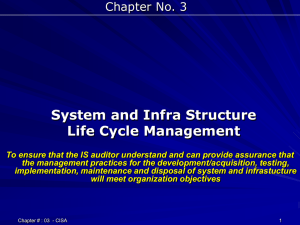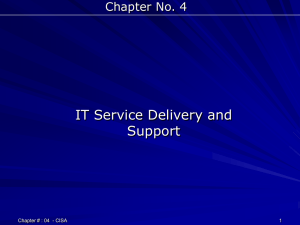Best Marketing Practices 101: Ideas for grower trainings and farmer
advertisement

Best Marketing Practices 101: Ideas for grower trainings and farmer resources Kelly Coleman CISA CISA’s brand • CISA owns the trademark to this brand. • Market in 3 counties in western MA • Tag “western MA Grown” Success •82% consumer recognition of brand •Consumers 2 x as likely to buy local •Over 240 members, 175 are farmers •Spend average of $25-30,000 on advertising a year Membership • • • • • • Farms Retailers Restaurants Specialty Products producers Institutions Garden centers/landscapers Examples of CISA’s efforts Farm to Consumer Connections Marketing 101 for farmers “I am not a marketing person – I didn’t ever expect to be a business owner.” “I got into farming because I love to grow– I didn’t want to be a marketer.” “With all the farmwork, its hard to find time to spend marketing it.” CISA’s plan • Run a 6 week course on marketing in the “off” season. • Invite farmers and community experts to be speakers. • Provide additional technical assistance to farms that attend the whole series, but also allow farms to pick and choose classes. • Write up resource sheets and lessons learned to share. Workshop 1: Why? • Everyone has limited resources and you HAVE to make decisions about where and how to market your business. • It is not easy to determine how to get the best bang for your buck. Your best marketing strategy builds on your plan. • Narrowly defining and committing to a specific marketing strategy or target audience can be really scary. Workshop 1: A marketing plan • • • • What is your marketing goal? What is your brand? Who is your audience? How are you/can you reach your target audience? • How do you make it all work together? Workshop 2: Paid Advertising • Advertising is a staple of marketing (but farm from the ONLY strategy)-- almost 70% of participating farms said they advertised already. • Determining where, when, and how often to advertise is not easy. Workshop 2: Paid Advertising Print benefits • People who read the local paper are interested in what is going on in their community. • Your ad has clear directions on how to find your farm and people can save it. • You can have the ad placed in the relevant section of the paper (food, weekend, etc) to find the kind of reader you want. Drawbacks • People toss the paper out every day; short shelf life. • Studies say that newspaper readership is dropping. Workshop 2: Paid Advertising Radio benefits • Radio is a great venue for storytelling about your farm. • A good radio ad creates a positive image of your farm. • Catchy ads are remembered long after they are gone. • Radio reaches a large mass market. • On-air appearances may come with ad contracts and add value to your investment. Drawbacks • People tune out radio ads at first. Repetition is the key. • Your ad needs to be compelling to break through ad clutter. Workshop 2: Paid Advertising Television benefits • In some rural markets, local TV stations have a captive audience that is far larger than print and radio combined. • Good visuals can show viewers how beautiful your farm is or how fun your festival will be. Drawbacks • Self-produced ads can be hokey. • If you are not comfortable being on camera, this may not be the venue for you. • Ads can be produced without showing the farmer, but studies show that consumers want to connect a real person to their food. Workshop 2: Paid Advertising Internet Banner benefits • Can target to particular audience. • Relatively easy to track “hits”/interest. Drawbacks • You need a good website to make this worth the investment. • Is your audience on-line? Workshop 2: Paid Advertising • Cost per thousand impressions or CPM. “how much am I getting for my money?” • Use duplicated numbers of individuals (in your target audience) reached in an average 4-week period. • The lower the CPM the more cost-efficient the buy. Workshop 3: Earned Media Your money or your life? • Building a relationship with the media • Writing press releases • Creating press-worthy events, activities, stories, etc. • Content marketing Workshop 3: Earned Media • Create a press list (include at least one generic address for each outlet: editor@news-outlet.com) • Introduce yourself – what are you an expert in? How can you help journalists? • Write your press release so it could be printed word-for-word. • Send via body of email – no attachments. Workshop 3: Earned Media Workshop 4: Merchandising • Often overlooked – but critical part of marketing. • Everything from roadside signs to retail displays and store flow to customer service. • Be visible, be neat/clean, be nice. Workshop 4: Merchandising Tips for displays • Create sense of abundance • Eye level and off the ground! • Use good signage Workshop 5: Internet • • • • Websites Email newsletters Blogs On-line stores Workshop 6: Your Marketing Plan • Participants were the focus– each participant shared two marketing strategies they would pursue. • All presenters were there to ask questions, provide advice. • Other attendees are a wealth of knowledge too. • Attendees who participated in 4 workshops and presented got 1:1 assistance with an expert. Keys to success • Make sure your series is relevant to your community. • Vet your speakers and work with them before they present! • Consistent attendance creates rapport among class. • Leave time for networking. What they said • “I was working on my brochure when I attended the first workshop: it helped me focus a lot.” • “The website session was really helpful.” • “The series was a tremendous opportunity to hear other people talk – I got energized just listening.”











